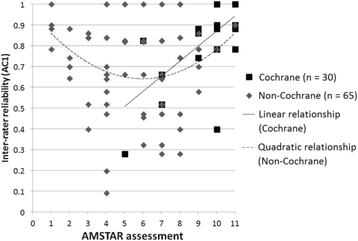Evaluation of AMSTAR to assess the methodological quality of systematic reviews in overviews of reviews of healthcare interventions
- PMID: 28335734
- PMCID: PMC5364717
- DOI: 10.1186/s12874-017-0325-5
Evaluation of AMSTAR to assess the methodological quality of systematic reviews in overviews of reviews of healthcare interventions
Abstract
Background: Overviews of reviews (overviews) compile information from multiple systematic reviews (SRs) to provide a single synthesis of relevant evidence for decision-making. It is recommended that authors assess and report the methodological quality of SRs in overviews-for example, using A MeaSurement Tool to Assess systematic Reviews (AMSTAR). Currently, there is variation in whether and how overview authors assess and report SR quality, and limited guidance is available. Our objectives were to: examine methodological considerations involved in using AMSTAR to assess the quality of Cochrane and non-Cochrane SRs in overviews of healthcare interventions; identify challenges (and develop potential decision rules) when using AMSTAR in overviews; and examine the potential impact of considering methodological quality when making inclusion decisions in overviews.
Methods: We selected seven overviews of healthcare interventions and included all SRs meeting each overview's inclusion criteria. For each SR, two reviewers independently conducted AMSTAR assessments with consensus and discussed challenges encountered. We also examined the correlation between AMSTAR assessments and SR results/conclusions.
Results: Ninety-five SRs were included (30 Cochrane, 65 non-Cochrane). Mean AMSTAR assessments (9.6/11 vs. 5.5/11; p < 0.001) and inter-rater reliability (AC1 statistic: 0.84 vs. 0.69; "almost perfect" vs. "substantial" using the Landis & Koch criteria) were higher for Cochrane compared to non-Cochrane SRs. Four challenges were identified when applying AMSTAR in overviews: the scope of the SRs and overviews often differed; SRs examining similar topics sometimes made different methodological decisions; reporting of non-Cochrane SRs was sometimes poor; and some non-Cochrane SRs included other SRs as well as primary studies. Decision rules were developed to address each challenge. We found no evidence that AMSTAR assessments were correlated with SR results/conclusions.
Conclusions: Results indicate that the AMSTAR tool can be used successfully in overviews that include Cochrane and non-Cochrane SRs, though decision rules may be useful to circumvent common challenges. Findings support existing recommendations that quality assessments of SRs in overviews be conducted independently, in duplicate, with a process for consensus. Results also suggest that using methodological quality to guide inclusion decisions (e.g., to exclude poorly conducted and reported SRs) may not introduce bias into the overview process.
Keywords: Bias; Knowledge synthesis; Methodological quality; Observer agreement; Overview of reviews; Systematic review.
Figures


References
-
- Green S, Higgins JPT, Alderson P, Clarke M, Mulrow CD, Oxman AD. Chapter 1: Introduction. In: Higgins JPT, Green S, editors. Cochrane Handbook for Systematic Reviews of Interventions Version 5.1.0. The Cochrane Collaboration; 2011. www.handbook.cochrane.org.
-
- Becker LA, Oxman AD. Chapter 22: Overviews of reviews. In: Higgins JPT, Green S, editors. Cochrane Handbook for Systematic Reviews of Interventions Version 5.1.0. The Cochrane Collaboration; 2011. www.handbook.cochrane.org.
Publication types
MeSH terms
Grants and funding
LinkOut - more resources
Full Text Sources
Other Literature Sources
Research Materials

